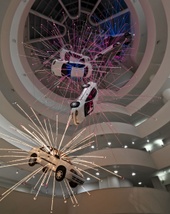
Cai Guo-Qiang "I Want to Believe"
at Guggenheim Museum
in the Upper East Side area
This event has ended - (2008-02-22 - 2008-05-28)
Sometimes seeing is not believing. A case in point is the exhibit Cai Guo-Qiang: I Want to Believe at the Solomon R. Guggenheim Museum in which you are quite dramatically drawn into what he believes. Cai’s rendering of an ideal world is embedded with metaphysical and cosmological ideas that permeate his oeuvre. The show features gunpowder drawings from the late 80s as well as his recent installation works.
When entering the building, the first thing you see is a sequence of nine white Chevy cars with blinking light tubes bursting out of their bodies, flying up in the rotunda space (Inopportune: Stage One). They aggressively draw viewers’ eyes to the top of ceiling. The movement is even more radical and violent when compared to the piece’s customary horizontal installation. Just as flamboyant are a herd of wolf replicas smashing into a transparent wall (Head On) and a number of clay sculptures of mistreated peasants (Venice’s Rent Collection Courtyard) which both carry Cai’s overt political messages. In Head On, Cai warns against the blind following of ideology by the masses. The latter work is a commentary on China’s use of social realist art as propaganda to serve the purposes of communist idealism during the Cultural Revolution, which started when Cai was nine years old. When you walk through these installations, you realize that you are physically placing yourself among wolves and peasants rather than observing them from a distance. Taking full advantage of the Guggenheim’s narrow, sloping ramp space, the works emphasize an experiential aspect rather than mere spectacle.
After a rather jumpy transition, the installations are followed by Cai’s renowned gunpowder drawings, which make up the best of the exhibition. Surprisingly, the drawings are just as articulate as the explosions themselves, which can be seen in accompanying video. The gunpowder drawings trace the passage of time from initial plan to the drawing process and culmination of the work. Fetus Movement II: Project for Extraterrestrials No. 9 is a perfect case in point. The work corresponds to the explosion that he orchestrated at a military base in Germany three years after the collapse of the Berlin Wall. During the explosion, Cai monitored his heart rate and brainwaves, which corresponded to the vibrations from the land. In the drawing, the four layers of radiation created by the gunpowder explosion, a small white figure in the center of the circle, and the text that describes his plan all work together to recreate the event temporarily in your mind.
While traditional Chinese scroll painting reads horizontally, Cai’s gunpowder works draw the audience into his time travel from a single vantage point. Just as Taoism embraces the notion of contrast, the drawings simultaneously feature the event and its trace. The sublime explosion is paradoxically present in the work through the residue of gunpowder that draws its exquisite ragged contours.
This exhibition is a great inauguration of the Contemporary Asian art department headed by senior curator Alexandra Munroe. The constant crowd in the exhibition space certainly tells us that many museumgoers have been hungry for such an explosion of personal expression and energy from the opposite side of the earth.¿Buscas adrenalina y emoción? Los nuevos casinos online casinos-online-nuevos.mx ofrecen una experiencia única con juegos innovadores y premios tentadores. Únete a la revolución del juego en línea y descubre la emoción desde casa.

Comments